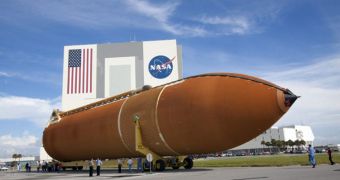After more than 37 years of working on producing the external fuel tanks for the US space shuttles, the NASA Michoud Assembly Plant has just stopped producing the components.
This is happening as the American space agency is nearing the end of its Space Shuttle Program, a flagship initiative that has kept the public fascinated for decades.
There are now only three more shuttle flights left. One will see Discovery launch in November, the other will take Endeavor to space in February, and the last one will see Atlantis take off in June, 2010.
All three missions are destined to go to the International Space Station (ISS), where they will deliver important components, spare parts and supply to the permanent, six-astronaut crew onboard.
Originally, Endeavor's February flight was supposed to be the last shuttle mission, but a new bill that Congress passed on September 29 approved an additional flight beyond that date.
Regardless of the program extension, there is little left to do for the workers that build the orange external fuel tanks. Lockheed Martin is the main contractor, and the company is conducting its activities from the Michoud plant.
In a little less than four decades, the company managed to build no less than 136 of these external fuel tanks. But production stops on October 1, announced in a September 30 statement officials at Lockheed.
This was clearly visible in the number of employees working for the company. At the start of this year, more than 1,400 highly-skilled workers were employed at the Michoud production facility, but now only about 600 remain.
“We had 300 people that were released from the program today,” told Space on Thursday Lockheed Martin spokesman Marion LaNasa.
Of the remaining staff, about 200 will carry on working on the Orion Crew Exploration Vehicle, the part of Project Constellation that was to be the direct successor of the space shuttle.
The other 400 employees will continue to supervise shuttle operations until Atlantis' final flight. “They'll do anything and everything that's needed to disposition a tank for flight,” LaNasa said.
It is not uncommon for external fuel tanks to become damaged before a shuttle launch. In 2007, for example, a storm threw small pebbles into a tank that was already at its launch pad.
The reservoir was then sent back to the Michoud plant, all the way from the Kennedy Space Center, in Cape Canaveral to New Orleans, for repairs.
After reconditioning, the tank was returned to the KSC, where it was mated with space shuttle Atlantis, which then proceeded to successfully complete its mission.

 14 DAY TRIAL //
14 DAY TRIAL //